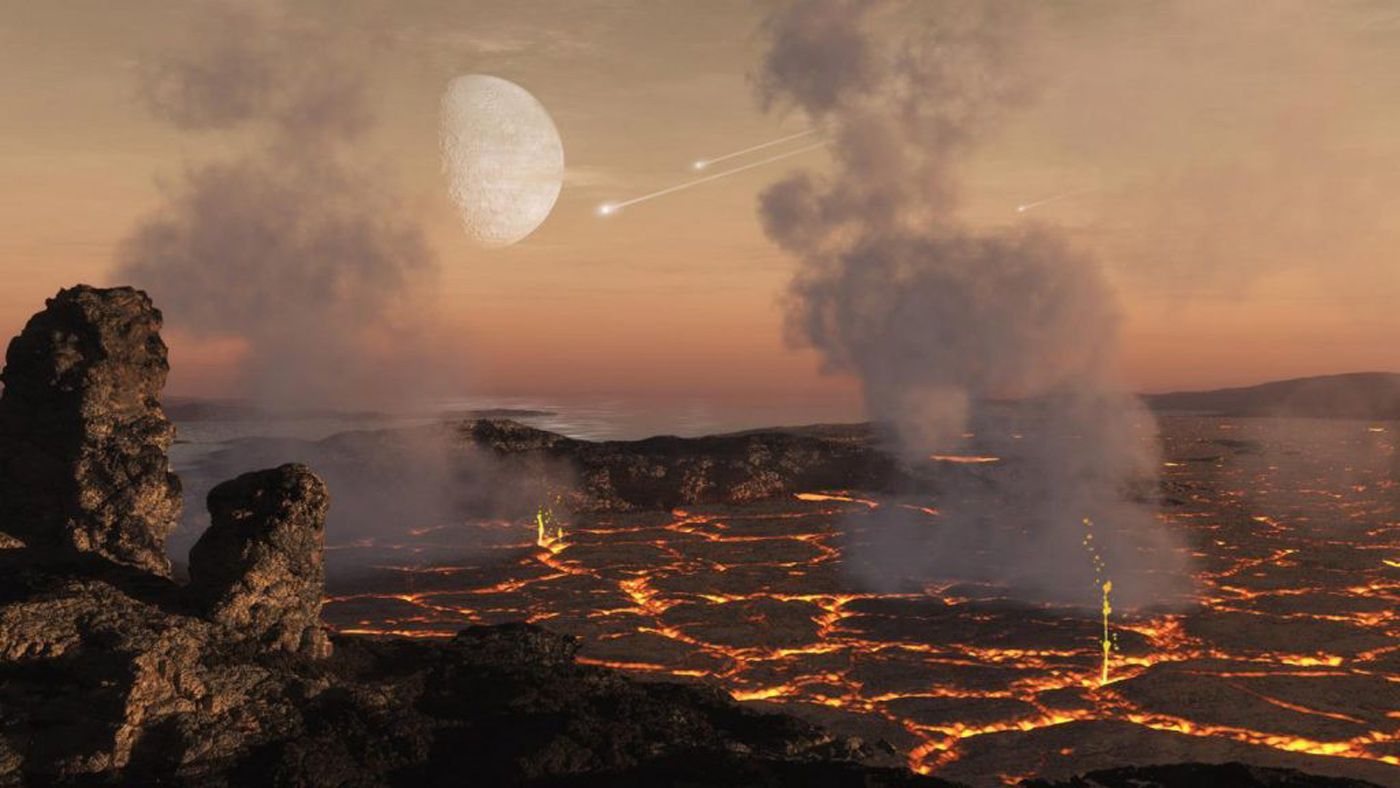
Six stories that examine atmospheres, both here on Earth and on exoplanets.
Let’s start with Earth, where a team of scientists from UC Santa Cruz baked meteorites at 1200 degrees Celsius and then sampled the resulting gases produced using a mass spectrometer. Overall, water was predominant, followed by large amounts of carbon monoxide and carbon dioxide, and then smaller amounts of hydrogen and hydrogen sulfide.
These results are interesting because up until this research, most atmospheric models assumed gases with solar abundances; in other words, heavy on hydrogen and helium. As coauthor Myriam Telus explains: Based on outgassing from meteorites, however, you would expect water vapor to be the dominant gas, followed by carbon monoxide and carbon dioxide. Using solar abundances is fine for large, Jupiter-size planets that acquire their atmospheres from the solar nebula, but smaller planets are thought to get their atmospheres more from outgassing.
Putting it another way, the atmospheres of rocky planets were thought to derive mostly from the gas released due to the intense heat of pulling together all the building blocks and material as well as later volcanic eruptions and outgassing. And this research, which is published in Nature Astronomy, shows that the primitive rocky material in our own solar system contained just such gases as we see in our atmosphere. Side benefit, we can use this information to narrow down our search for certain kinds of exoplanets. Yay for science working as predicted!
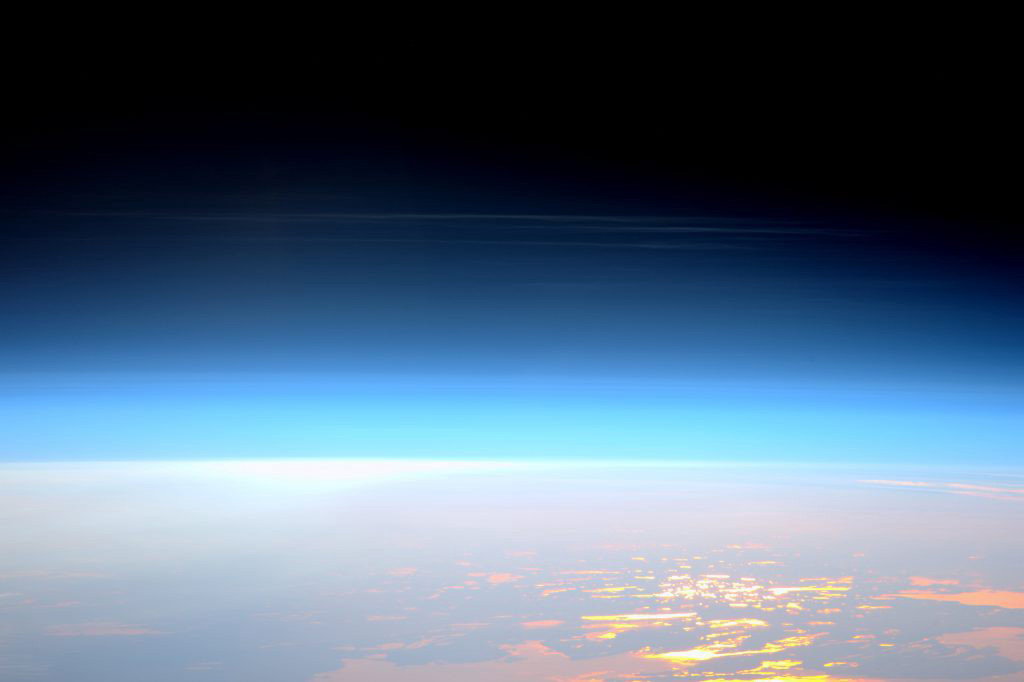
Speaking of our own atmosphere, we need to understand how it works if we are to look for similar atmospheric conditions around other planets. Also, we keep talking about this pesky climate change concern, greenhouse gases, and what the future holds if we don’t cool things down. While we have a lot of info about what is going on near the surface of Earth, the upper atmosphere is difficult to understand since the water vapor in the air distorts any data taken, and space instruments haven’t been able to make direct measurements. Additionally, a lot of the data already collected during other observations has been considered noise and discarded. So while climate models predict that temperatures in the upper atmosphere will decrease due to greenhouse gases, scientists were unable to test out their models in reality.
Now, thanks to the SOFIA airborne telescope, we can directly measure the atomic oxygen in the upper atmosphere, and the results match all those snippets of direct measurements from rocket and Space Shuttle instruments as well as the indirect satellite measurements. The confirmation results were published in Nature Communications Earth and Environment using data collected in 2015 during the same flight that observed the Jellyfish nebula we talked about recently. Researchers intend to apply similar analytical methods to data taken during other flights and in different seasons to see just how the atomic oxygen amounts change with location and time.
From oxygen in the atmosphere, we go to rain. A pair of scientists at Harvard recently published a paper in the Journal of Geophysical Research: Planets examining the physics of raindrops and how they might work in different atmospheres. Lead author Robin Wordsworth explains: The humble raindrop is a vital component of the precipitation cycle for all planets. If we understand how individual raindrops behave, we can better represent rainfall in complex climate models.

And it turns out? Raindrops are pretty much raindrops no matter where they fall, although whether or not they reach the surface is a matter of size: too big and the surface tension isn’t enough to hold drops together; too small and the drop evaporates in the atmosphere. What makes a drop “just right”? Well, here you have to combine a few properties — drop shape, falling speed, and evaporation speed.
Drop shapes are pretty similar no matter the material: spherical when small and then squashed flat as they grow. The falling speed is basically a question of the planet’s gravity and the density of the atmosphere. Evaporation speed is the trickstery factor, but taking all that into account led Wordsworth and grad student Kaitlyn Loftus to conclude that no matter the conditions, only a small fraction of drops hit the surface. Again, understanding Earth can help us find the habitable exoplanets we’re looking for, at least so far as life as we know it is considered.
It also turns out that atmospheres can be used to understand the history of an exoplanet, not just its current state. An international team of scientists analyzed the atmosphere of HD 209458b using high-resolution spectra gathered by the Telescopio Nazionale Galileo in La Palma, Spain.
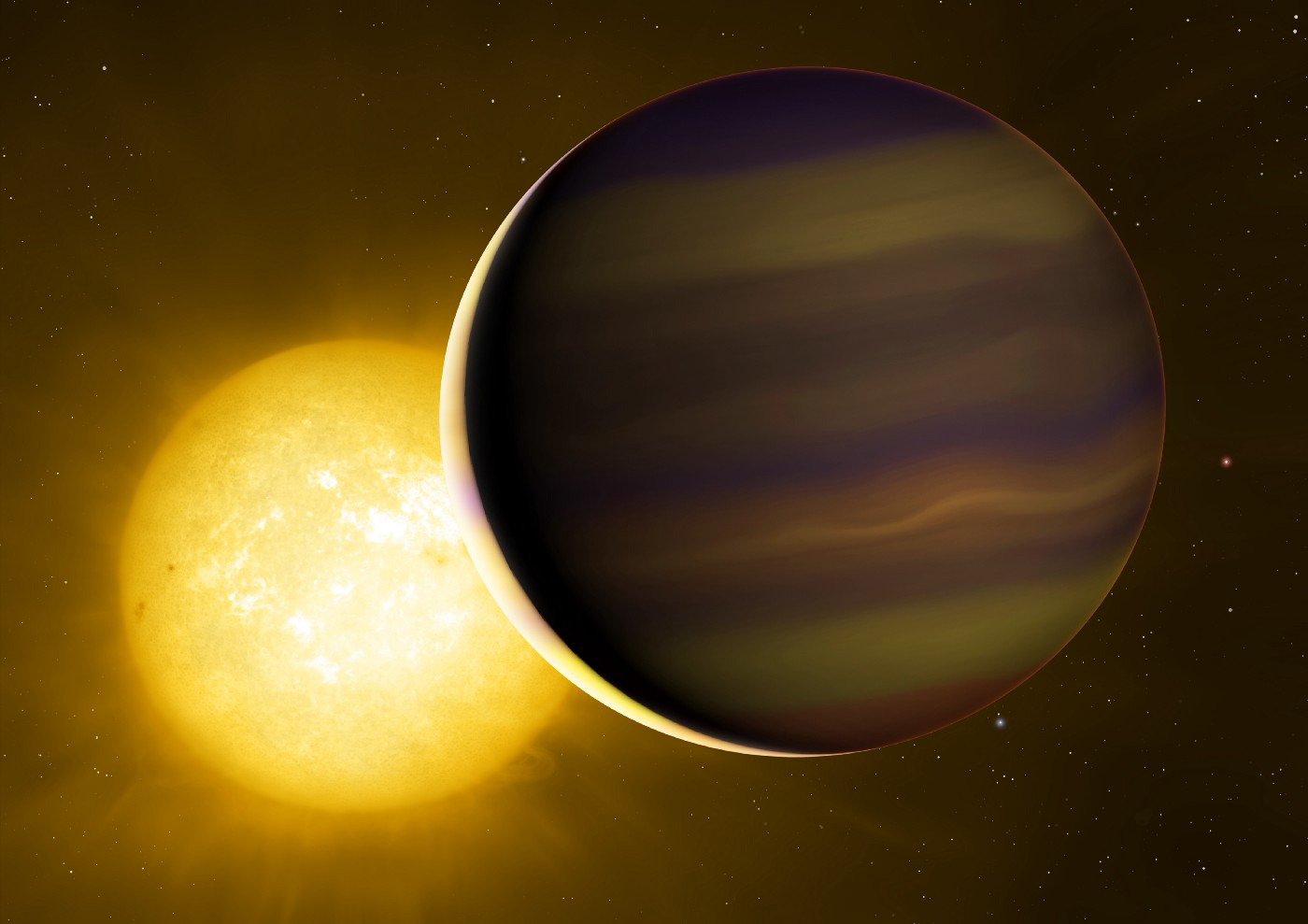
As an exoplanet transits in front of its host star, the light from the star passes through the planet’s atmosphere, exciting the molecules such that they give off energy as they return to their original states, and the light given off by that energy means we can figure out what the molecules are. In this case, the astronomers detected hydrogen cyanide, methane, acetylene, carbon monoxide, ammonia, and a bit of water vapor.
The first four of those are all carbon-based molecules, and that is incredibly unexpected for a planet as close in to its star as HD 209458b is — a mere seven million kilometers away — which leads the team to propose that this exoplanet actually formed much farther out, far beyond the point where water changes from liquid to gas. Coauthor Dr. Siddharth Gandhi notes: There is no way that a planet would form with an atmosphere so rich in carbon if it is within the condensation line of water vapor. At the very hot temperature of this planet (1,500K), if the atmosphere contains all the elements in the same proportion as in the parent star, oxygen should be twice more abundant than carbon and mostly bonded with hydrogen to form water or to carbon to form carbon monoxide.
Remember, this is a giant planet, not a rocky body, so it should have the same composition as its star, and it does not. Every new paper teaches us something more about planetary formation, and we keep inching closer and closer to finding that first truly habitable exoplanet.
Now that we’ve talked about some of the things we can detect in the atmosphere, from atomic oxygen to water vapor to a variety of carbon-based molecules, why do we really care? Sure, we want to find an exoplanet that we can call habitable, at least to life as we know it. We have a sample size of one when it comes to habitable planets, and we’d like to increase that sample. That’s all well and good. But you know and I definitely know that it’s really about finding life. Not just where it could live, but where it does live.
Our previous story showed that we can use spectroscopy to detect the chemical fingerprint of an exoplanet. And my next two stories are going to look at some of the pitfalls we may face when making those directions.
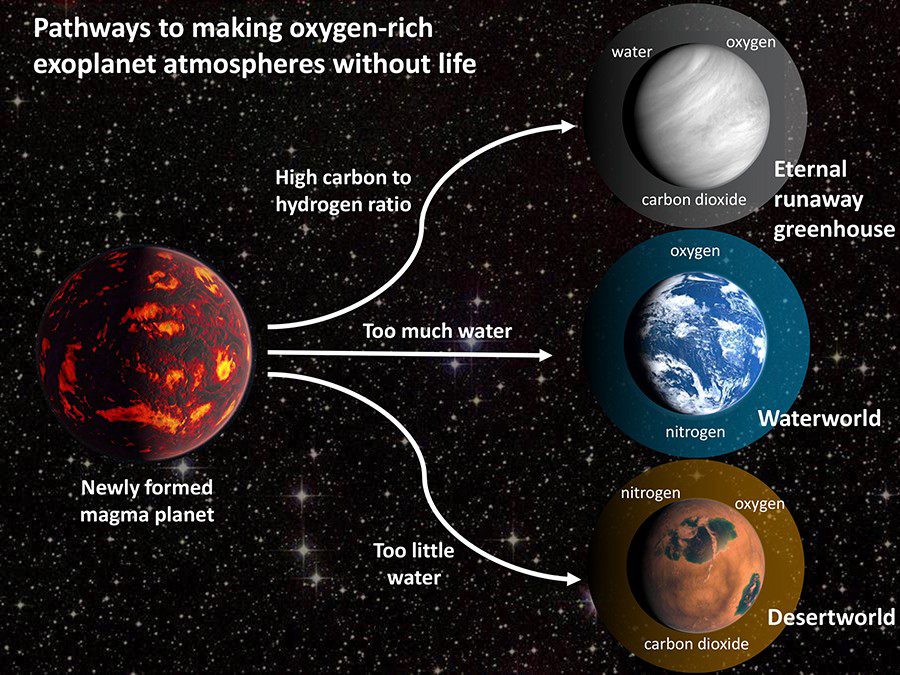
First, let’s talk about oxygen. We’ve mentioned it a few times today, particularly in the context of Earth and our own solar system. We know we have life here. But then we talked about a world’s atmosphere that was far more carbon-based than oxygen-based. This is fine because that planet is too close in and too big to be habitable to the type of life we have here. Sure. Fine. All well and good. Does that mean oxygen is a sure-fire biosignature? No. But new research published this week in AGU Advances seeks to break down how to distinguish between potential “oxygen false positives” and actual signs of life.
The team came up with three different scenarios to potentially explain an abundance of oxygen that isn’t a result of life. Scenario one: oxygen builds up in the upper atmosphere as ultraviolet light breaks apart water molecules in the constituent oxygen and hydrogen. The hydrogen is much lighter, and it tends to escape into space more than the oxygen does. Then add in the outgassing from volcanoes, as mentioned earlier, and now we have carbon monoxide and more hydrogen to add to the mix. Carbon and oxygen like to react, so the oxygen gets pulled into more molecules, and the weathering of rocks on the surface contributes to pulling oxygen out of the atmosphere.
Scenario two: the planet doesn’t have a lot of water, to begin with, so the molten surface of the early planet solidifies quickly before the water that is there condenses. Now you have a steamy atmosphere with a lot of water molecules to break up as before, leaving oxygen behind as the hydrogen, again, escapes.
Then in scenario three, you can have a planet with a runaway greenhouse effect, like Venus, where there is more carbon dioxide than water, and then water cannot condense due to the heat, and so a whole bunch of oxygen-based molecules is just lingering in the atmosphere. It’s all a big, complicated set of processes that add up to one core issue: oxygen comes and goes for more reasons than the respiration of a planet’s inhabitants.
Now here’s the important part, as explained by co-author Jonathan Fortney: There has been a lot of discussion about whether detection of oxygen is ‘enough’ of a sign of life. This work really argues for needing to know the context of your detection. What other molecules are found in addition to oxygen, or not found, and what does that tell you about the planet’s evolution?
Remember those six molecules detected in our last story that told us the planet had to form elsewhere? That’s the kind of chemical fingerprint we’re going to need before claiming any sort of biosignature has been found. It’s more than just oxygen. It’s everything. And the team behind this paper is essentially arguing that we need the right instruments on all these upcoming next-generation telescopes to get the spectra we need from exoplanet atmospheres in order to find that first proper biosignature.
The mere thought of it makes me giddy.
Oh, and there’s another study to help out here. In new research published in Frontiers in Astronomy and Space Sciences, a team of scientists explained how they used computer algorithms to identify the spectral signatures of almost a thousand molecules containing phosphorus. That catalog can now be used to compare future findings and make the identification of atmospheric molecules far easier.
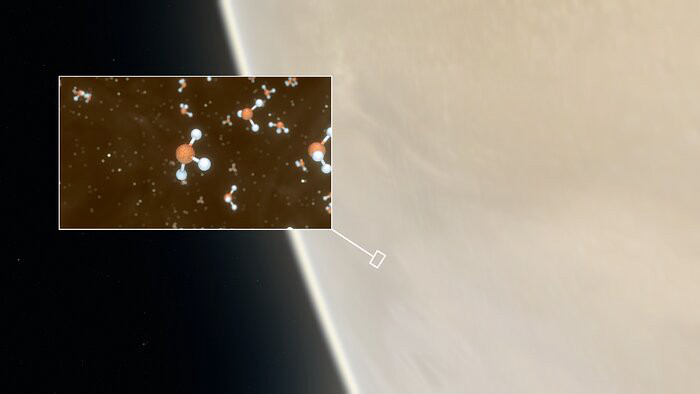
So why phosphorus when I’ve been talking about oxygen all this time? Well, first, there was that whole kerfuffle from last year about detecting phosphine on Venus. The back and forth that played out in the journal was definitely an impetus for this particular modeling project. But also, phosphorus is essential for life, again, as far as we know it. And phosphine was the only molecule we knew how to detect. Now we have 957 other molecules that could maybe, just maybe, indicate life.
Dr. Laura McKemmish of the University of New South Wales, which led the research, explains: Though this new dataset doesn’t yet have the accuracy to enable new detections, it can help prevent misassignments by highlighting the potential for multiple molecular species having similar spectral barcodes — for example, at low resolution with some telescopes, water, and alcohol could be indistinguishable. The data can also be used to rank how easy a molecule is to detect.
Take that phosphine! We’re coming for you. You and 957 of your best friends as well as oxygen and carbon dioxide and water and… well, you get the idea.
References
These Asteroids Were Baked… For Science!
- UCSC press release
- Composition of terrestrial exoplanet atmospheres from meteorite outgassing experiments,” Maggie A. Thompson et al., 2021 April 15, Nature Astronomy
SOFIA Measures Atomic Oxygen in Earth’s Atmosphere
- NASA press release
- SOFIA press release
- Direct measurements of atomic oxygen in the mesosphere and lower thermosphere using terahertz heterodyne spectroscopy,” Heiko Richter et al., 2021 January 26, Nature Communications Earth & Environment
Raindrops Keep Fallin’ on Exoplanets
- Harvard press release
- AGU press release
- “The Physics of Falling Raindrops in Diverse Planetary Atmospheres,” Kaitlyn Loftus Robin and D. Wordsworth, 2021 March 15, JGR: Planets
Chemical Fingerprint Reveals Exoplanet’s Past
- University of Warwick press release
- “Five carbon- and nitrogen-bearing species in a hot giant planet’s atmosphere,” Paolo Giacobbe et al., 2021 April 7, Nature
Oxygen is Not a Reliable Biosignature, Study Finds
- UCSC press release
- “Oxygen False Positives on Habitable Zone Planets Around Sun‐Like Stars,” Joshua Krissansen‐Totton, Jonathan J. Fortney, Francis Nimmo, and Nicholas Wogan, 2021 April 13, AGU Advances
Catalog of Phosphorous Molecule and Their Spectral Signatures Created
- UNSW Sydney press release
- “Computational Infrared Spectroscopy of 958 Phosphorus-Bearing Molecules,” Juan C. Zapata Trujillo et al., 2021 April 8, Frontiers in Astronomy and Space Sciences
originally posted for Medium on May 3, 2021





